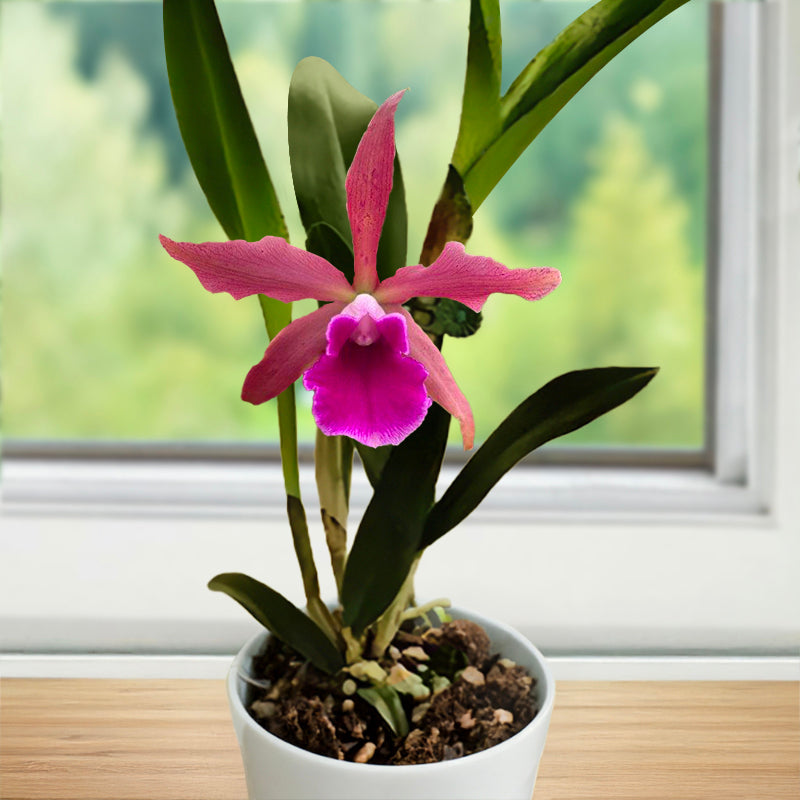Growing Cattleya Orchids
Cattleya Orchids are some of the most beautiful orchids in the world. Their stunning colors make them beloved jewels of the jungle. To understand their culture and care we need to look at their native habitat. They grow in the upper story of the jungle forest canopy and are epiphytes. They need a porous potting mix and should never sit in water. Cattleyas also grow as rhizomes; that simply means their stem runs along the ground or tree trunk from which arise pseudobulbs and leaves.
Cattleya Orchid Care Information
Light
Cattleyas need high light, high enough to turn the leaves pale in color not a deep green. This is healthy. If you see cattleyas with a deep green leaf color, then they are not getting enough light.
Temperature
Cattleyas grow best in day temperatures that range from 65° to 85° with the minimum night temperature around 55°. We recommend night temperatures above 60°.
Watering
They need periods of dryness between waterings and should never sit in a saucer of water. Basically the potting medium should be brought to near dryness between waterings.
Containers or Pots
We recommend growing in clay pots so water is wicked away from the root system, keeping the plants healthy. The potting media in clay pots dries out quicker and this makes for healthier roots.
Fertilizing and Feed
There are several types of orchid fertilizers available on the market including those to promote growth or bloom. We recommend a dilute fertilizer solution every other watering. Then flush with clear water between fertilizer applications. Orchids are meager feeders but they do benefit from fertilization.
Flowering
With good care and culture, cattleyas will flower reliably once, or even twice, a year. As new growth matures, the flower buds form where the leaves meet the pseudobulb. In some varieties the floral sheath will emerge along with the maturing growth. Others varieties will wait until there is a seasonal change in daylength before the flowers begin to grow. It's always the older leaves and stems that produce the energy for next year's bloom.
Repotting
Cattleyas have rhizomes that grow in one direction. They generally need to be repotted so they don't run out of their pot. Sometimes bark or coir potting media can get too old. When the media breaks down then moisture is held against the roots and the root system can be damaged. At the time of repotting, divide the plant up so there are at least three mature pseudobulbs and leaves. This provides enough energy to the plant for the ensuing year's growth so it's strong enough to produce flowers. Cattleyas should not be grown in soil or potting mix. Plant them in coir chips, fir bark or loose clay aggregate so there is plenty of air for the roots.
Pruning
Plants are generally not pruned, however, flowers and the old flower stems can be removed after blooming.
Re-blooming
If Cattleyas don't re-bloom, it's generally a light level issue. They are not a low light plant and need to be grown in a south, southeast or southwest window. Too much sunlight can burn the leaves, but make sure your leaves look yellow. People generally think yellow leaves indicate that the plant needs fertilizer, but this is perfectly natural for cattleyas.
Pests
They are not too susceptible to pests. There are some insects that can get on them. But generally they are pest free.
Fungal Diseases
Occasionally black spots appear on the leaves but if they are in warm enough temperatures and are able to dry down between waterings, then you should not have fungus problems. Root disease can be an issue but proper watering and an occasional repotting will eliminate it.
Challenges with Cattleyas
Roots are the key to having a healthy Cattleya. You must have open air media that is not decomposing and do not let cattleya orchids sit in water.
Watch our video below on how to grow and repot cattleya orchids:
Cattleya Orchid Care Summary
Cattleya orchids are vibrant, epiphytic plants known for their striking flowers. Native to the jungle canopy, they grow on trees and need well-aerated, non-soil media. Key to their care is mimicking their natural habitat.

